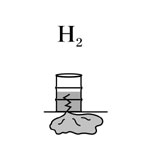| Case Name |
Leakage of hydrogen caused due to misuse of a gasket at a hydrogenation desulfurizing unit of an oil refinery |
| Pictograph |

|
| Date |
August 18, 1994 |
| Place |
Kawasaki, Kanagawa, Japan |
| Location |
Refinery |
| Overview |
In August, 1994, a turnaround shutdown was completed and operation of a hydro-desulfurization unit started. At 70 minutes after usual operation started, hydrogen and light oil leaked from the flange of the heat exchanger of the reactor, and there was a fire. The cause was not having a regular gasket replaced with a temporary gasket used for maintenance work. |
| Incident |
A leakage accident occurred at a hydro-desulfurization unit of an oil refinery. The unit had finished start-up after a turnaround shutdown. As the flange gasket of the vent nozzle at outlet piping of the reactor was damaged, hydrogen and light oil leaked as a mist 70 minutes after starting of usual operation. The piping was intermediate piping between heat exchangers used to recover the reaction heat.
The reaction was performed in the high-temperature and high-pressure hydrogen atmosphere. |
| Processing |
Manufacture |
| Individual Process |
Maintenance |
| Substance |
Hydrogen, Fig3 |
| Light fraction oil |
| Type of Accident |
Leakage |
| Sequence |
In a turnaround shutdown, temporary piping was attached to the vent nozzle of outlet piping of the reactor, and the reactor was washed. At that time, a gasket made of rubber was used for the flange of the vent nozzle.
After the work, the blind flange of the vent nozzle was attached where temporary piping was removed at the time of restoration.
About 08:56 on August 18th, 1994; starting up the unit was finished and it shifted to usual operation.
About 10:06; as the gasket of the flange was damaged, hydrogen and light oil leaked as a mist.
10:19; the leakage was informed the fire department. A steam curtain was operated to prevent the leaking gas from diffusing to a heating furnace. The unit was shut down immediately. After the pressure in the unit had fallen, the inside of the reactor section was replaced with nitrogen.
12:25; An emergency shutdown procedure was completed.
The quantity of the leak was presumed to be 3000 N cubic meters of gas mainly hydrogen and about 500 L of light oil. |
| Cause |
The flange, which was opened at a turnaround shutdown and had a temporary gasket, was restored during still using the temporary rubber gasket without changing to a regular SUS gasket. Therefore, the rubber gasket gradually hardened due to a high temperature and high pressure, and was destroyed. Communication between subcontractors was bad.
As a gas leak detector was installed near the ground, the leak of gas that was lighter than air was not detected.
The correct work procedure is shown in Fig2. |
| Response |
The heating furnace was protected by a steam curtain. The unit was stopped immediately. The pressure of the unit was released immediately after the shutdown and nitrogen was filled. |
| Countermeasures |
Completion of the standard of working procedure on recovery operation. Strengthening of education and training for construction persons in charge and subcontractor's employees. |
| Knowledge Comment |
Operation using temporary parts for maintenance should be forbidden. The system in which temporary materials are reliably changed to regular materials is necessary. |
| Background |
1. The cause is considered to be a mistake in the specifications for repair, or their enforcement. Neither work management for every unit nor repair procedures was fixed.
2. The gasket used for regular operation was managed on the responsibility of the operating company. In almost all cases, a subcontractor uses only what was directed. The consciousness of management responsibility and the way of enforcement might be a problem, |
| Incidental Discussion |
A gas detector is not usually put at a high place, but when a leak of light gas is assumed to be likely in a building, it is necessary to install one also at a high place. |
| Reason for Adding to DB |
Example of leakage caused due to use of a temporary gasket |
| Scenario |
| Primary Scenario
|
Organizational Problems, Poor Management, Poor Repair Management, Carelessness, Insufficient Understanding, Insufficient Recognition of Risk, Planning and Design, Poor Planning, Poor Repair Management Planning, Usage, Maintenance/Repair, Poor Attention at Repair, Failure, Deformation, Gasket Failure, Secondary Damage, External Damage, Leakage
|
|
| Sources |
High Pressure Gas Safety Inst. of Japan, High-pressure gas protection overview, pp.156-157 (1995).
Assoc. for Safety Techniques of Dangerous Materials, Accident cases of dangerous materials. Cases of accidents with dangerous materials seminar, pp.143-144 (1996).
Kawasaki City Fire fighting station, Prevention division, Peace section, SS Oil. K refinery. Hydro-desulfurization unit gas leakage accident, Material of the Kawasaki City Complex safety countermeasures committee.
|
| Physical Damage |
About 3000 N cubic meters of combustible gas which was maily hydrogen and about 500 L of misty light oil were lost. |
| Financial Cost |
About ¥ 10,000. (Material of the Kawasaki City Complex safety countermeasure committee) |
| Multimedia Files |
Fig2.Operational procedure figure
|
|
Fig3.Chemical formula
|
| Field |
Chemicals and Plants
|
| Author |
ITAGAKI, Haruhiko (Japan National Institute of Occupational Safety and Health)
TAMURA, Masamitsu (Center for Risk Management and Safety Sciences, Yokohama National University)
|